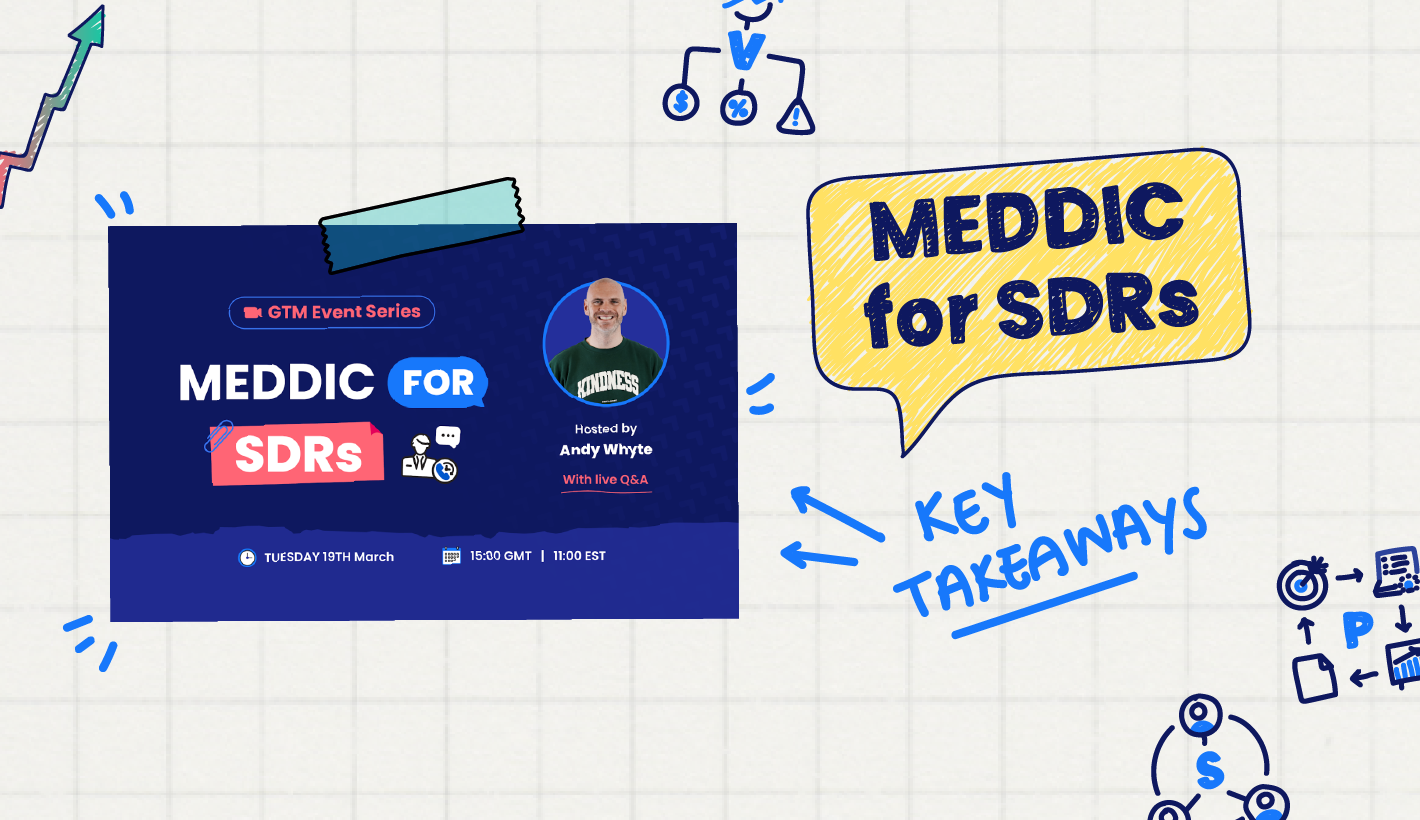The average salesperson might assume that the best way to increase revenue is to increase opportunities. After all, isn’t it the more the merrier? What we then see is a huge amount of innovation surrounding boosting the number of opportunities entering the pipeline, but a dearth of innovation in other areas. In a webinar, MEDDICC CEO Andy Whyte dove into how focusing on opportunities can be to a salesperson’s detriment, and how you can use MEDDPICC to boost your revenue in other ways.
What people tend to forget is that while opportunities are important, they are just one of four important levers in sales. The others are, of course, Average Contract Value, Conversion Rate, and Time to Close. While people recognise these levers, they are not put on the same level of importance as opportunities.
This is where the importance of the Sales Velocity Equation comes into play. It demonstrates, in simple numbers, the significance of improving upon each of the four above levers. If you didn’t already know:
Sales Velocity = ACV x Conversion Rate x Number of Opportunities / Time to Close
When we look at the Sales Velocity Equation, we can see the impact small changes across the board can make. If you want to get a more in-depth look at how you can use the Sales Velocity Equation, check out this article.
When we look at sales this way, the quality of your opportunities is what needs to be spotlighted. Which is better: 30 opportunities, 2/3rds of which are duds, or 10 solid opportunities? Using MEDDPICC, you can improve the quality of your opportunities, which can help with the other sales metrics too! Even if you improve upon each metric by simply 10%, the rewards you reap can be exponential.
So, let’s dive into the 8 actionable tactics you can use to improve each sales metric, and increase your revenue!
1. You’ve Got Qualification WrongWhen people think about qualifying leads, they forget to center the customer. This stage of selling shouldn’t involve you asking yourself, ‘Is there a deal here for me?’, but rather, ‘is my solution valuable to this customer?’. Your focus should be on the customer, not yourself. On a first meeting, instead of interrogating the customer about whether they’re qualified to buy (which, even if they are, they’re unlikely to know the answer to), spend your time with them demonstrating the value you know you can deliver to them! Otherwise you are a) not being fair to the customer and b) getting off to a bad start. When we center the customer in our qualification, we find ourselves with better quality opportunities, which leads to a higher conversion rate, and so on!
2. Preparation is a Force MultiplierWe all know the saying, fail to prepare, prepare to fail! When we show up to a meeting with a customer well-prepared, our likelihood of success increases - and the same can be said the other way. Researching your customer ahead of time shows that you care about what they do and what affects them. They will then be more likely to cooperate with you in discovering and Implicating their Pain, which can lead to an increase in Average Contract Value. On top of that, the more customers that sense your understanding of their pain, the higher your conversion rate will be. However, you can only sufficiently and properly prepare if you have the time, which means you will need to correctly qualify for value. You can’t prepare in depth for every potential prospect, so you need to qualify your leads to ensure you are giving your attention to the customers who will most benefit from your solution.
3. Spark To a FlameWhen you first have contact with your customer, that indicates a spark of interest. But how do you fan that spark of interest into a flame of passion? Focus on the decision process early. What would the customer need from you to add kindling to that fire? That’s where you need to focus your efforts. To find this information out, it’s important to be curious. Don’t interrogate your customer, but ask them questions like ‘What happened the last time you bought a solution like this?’ Make sure to be prepared, so you have answers to any questions they might in turn ask you. If they say, ‘If I bought your solution, how long would it take to be implemented?’, you can let them know straight away. By working alongside your prospect to understand what they would need to see to choose your solution, you can decrease the time to close because you aren’t just waiting for them to ask you questions, you’re already supplying them with the answers.
4. More People = More Problems (and that’s a good thing!)When you interact with just one stakeholder, the true value of your solution might not be felt. By implicating more people in that pain, you demonstrate the real value of your solution. When you show a stakeholder that the pain your solution solves impacts not just them, but their boss, and people from other departments, the more sharply that pain is felt company-wide. You can then increase your average contract value by illustrating how the problem pervades the company at multiple levels.
5. Map EverythingTo demonstrate the value of your solution, it’s important to get an idea of just how that value can be applied. That’s why we highly recommend mapping out everything. Who is involved in this deal? What do they care about? How do we engage with them? By answering these questions, you show every aspect of the value your solution provides. Identify the pain, then indicate it, and implicate it with metrics - this way your customer will have a clear idea of not only their pain, but everyone else’s. To ensure the effectiveness of this, though, you need to make sure to differentiate your solution! There is no point in simply outlining pain for the competition to swoop in and provide the customer with a worse solution because you didn’t properly explain your solution’s value. But how do you do this?
6. Influence the Decision CriteriaWhile the customer might have a rough idea of what they want from your solution, it’s likely that they won’t have the fine details narrowed down. That’s where you step in to show them how your solution is differentiated from the rest. Here, we tend to witness two types of seller. The first is the average seller, who focuses their attention solely on the technical aspects of their solution that the customer has already expressed an interest in. The elite seller, however, knows that they can differentiate their solution on three different fronts: technical, economic, and relationship. This way, you can shorten your time to close by not waiting around for the customer to ask you questions, you can tell them what makes you different from. By covering the various angles of why your solution is superior, you can also increase your Average Contract Value, as your customer may realize that you solve pain that you were as yet unaware of. The most important thing to remember when it comes to influencing the Decision Criteria is that your customer is not an expert on your product. It is your responsibility to be curious and show them how they can benefit!
7. Time to Close - the Forgotten MetricA deal can have all the potential in the world, but the time to close can make or break it. We at MEDDICC know that quarters (and careers!) are won and lost in time to close. The best way to decrease the time to close is to increase urgency. How do you do that? By wielding Pain and Value in tandem. When you simultaneously point out the pain that comes without your solution, and the value to be found with your solution, you create urgency. If you want to learn more about the formula to build urgency, check out this article. There are also important aspects of the deal that you need to be aligned with your customer on: what is the business case? What are the key initiatives? What will the process of the deal look like from start to finish? If you don’t have the answers to these questions, you may see your deal start to stagnate. Another good way to drive a deal forward and decrease the time to close is ensuring your Champion has a vested interest. How do you achieve that? With a compelling event!
8. Compelling EventWithout a compelling event, you are essentially just order-taking. If you don’t have one, create one! To do so, tie everything to value - ‘when X is implemented by [a certain date], you will see a Y% increase in ROI.’ Don’t just attempt to make incentives that don’t really drive the deal forward. Try to find a time-bound requirement, taking into consideration any compliance issues and the financial alignment involved. Make sure to take action, don’t just sit by the phone waiting for your customer!
We hope that with these 8 actionable tactics, you can go forward and improve your revenue from all angles, and not be so obsessed with opportunities!
Until next time - may your Champions be strong 💪
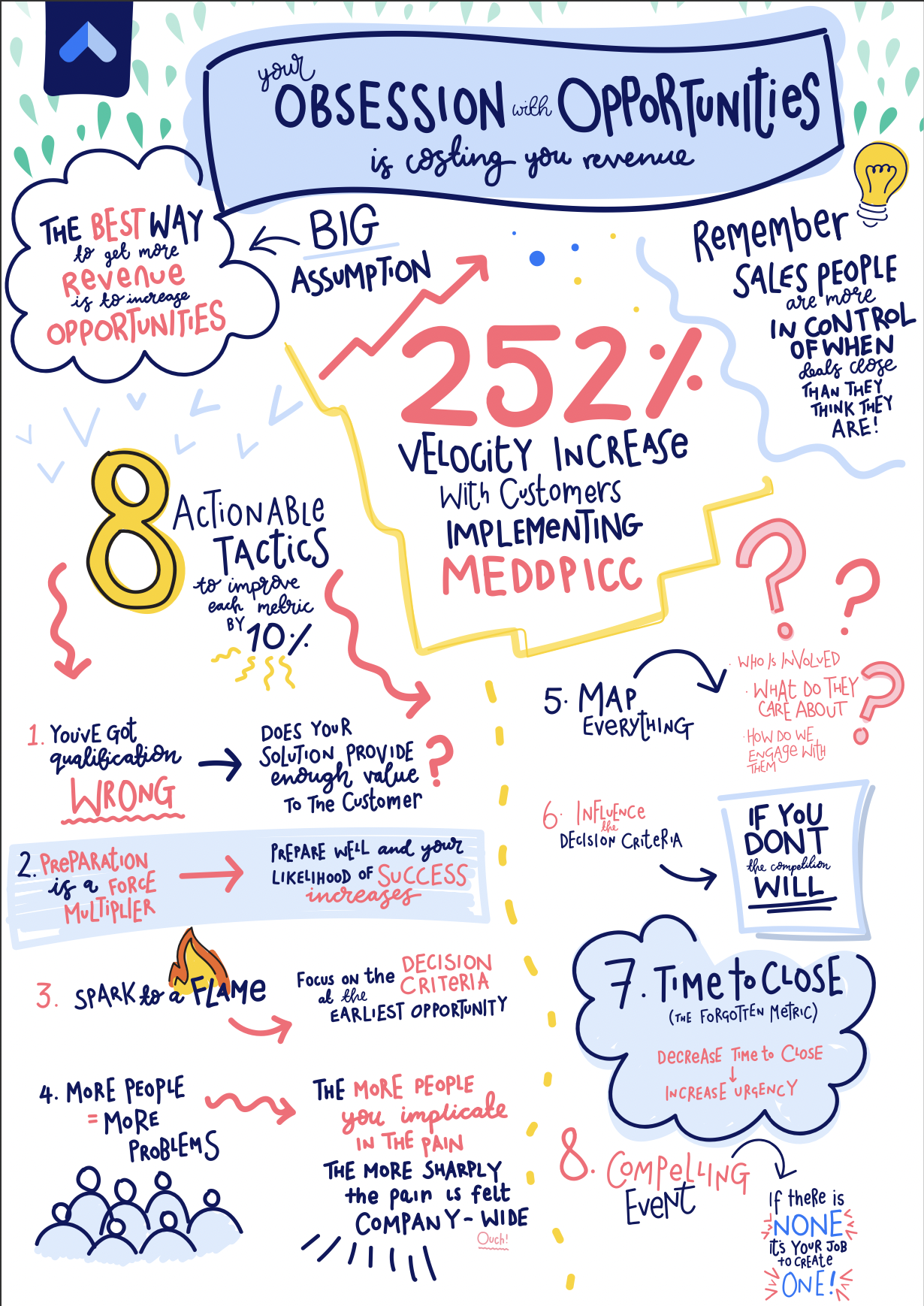





.png)





.png)

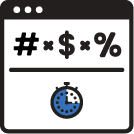









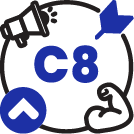






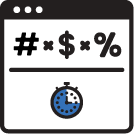





%201.png)








.png)

-1.png)
-1.png)
